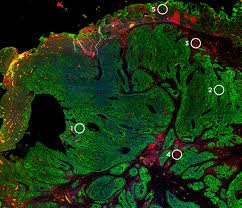Bio-Techne and Nucleai Demonstrate Predictive Power of Spatial Biomarkers in Melanoma
05 November 2025 | Wednesday | News

- Clinical trial data demonstrates how Bio-Techne's spatial biology technology and Nucleai's AI-powered multimodal platforms can identify predictive biomarkers in immunotherapy and targeted therapy-treated melanoma patients.
- Bio-Techne's COMET™ platform and Nucleai's multimodal spatial operating system profiled 42 biopsies, revealing immune cell interactions linked to clinical outcomes.
- Study selected by the scientific committee as one of the top 150 abstracts from over 1,200 submissions at SITC 2025.
Bio-Techne Corporation (NASDAQ: TECH), a global provider of life science tools, reagents, and diagnostic products, and Nucleai, a leader in AI-powered multimodal spatial biology for precision medicine, today announced the presentation of pivotal data from the SECOMBIT clinical trial at the Society for Immunotherapy of Cancer (SITC) 2025 Annual Meeting.
The study, conducted in collaboration with Professor Paolo Ascierto, Full Professor of Oncology at the University of Napoli Federico II and Istituto Nazionale Tumori IRCCS Fondazione Pascale, showcases the significance of spatial biology in translational research by combining, for the first time, an immuno-oncology (IO) multiplex immunofluorescence (mIF) panel with advanced AI-driven multimodal biomarker analysis.
Study Overview
Using the COMET platform and a 28-plex mIF panel, researchers profiled 42 pre-treatment biopsies from patients with metastatic melanoma. Nucleai's multimodal spatial operating system integrated high-plex imaging, histopathology, and clinical outcome data to identify distinct immune cell interactions that correlate with progression-free survival (PFS), overall survival (OS), and clinical benefit across three treatment arms incorporating Immune Checkpoint Blockade (ICB).
Key Findings
- Arm A (MAPKi → ICB): Immune activation markers such as PD-L1+ CD8 T-cells and ICOS+ CD4 T-cells are linked to better outcomes.
- Arm B (ICB → MAPKi): PD-1+ CD8 T-cells in the tumor invasive margin and their interactions with PD-L1+ CD4 T-cells correlated with improved survival.
- Arm C (MAPKi → ICB → MAPKi): APC-T-cell interactions in tumor margins associated with better outcomes; macrophage interactions in outer tumor microenvironment (TME) indicated poorer prognosis.
The study shows that where immune cells are located and how they interact within the tumor matters significantly for treatment success. By using AI and spatial biology to map these immune niches, researchers can better predict which patients will benefit from specific therapies moving toward more personalized and effective cancer treatment.
"This study exemplifies how our innovative spatial imaging and analysis workflow can be applied broadly to clinical research to ultimately transform clinical decision-making in immuno-oncology," said Matt McManus, President of the Diagnostics and Spatial Biology Segment at Bio-Techne
"Our multimodal spatial operating system enables integration of high-plex imaging, data, and clinical information to identify predictive biomarkers in clinical settings," said Avi Veidman, CEO of Nucleai. "This collaboration shows how precision medicine products can become more accurate, explainable, and differentiated when powered by high-plex spatial proteomics – not limited by low-plex or H&E data alone."
"The SECOMBIT trial is a milestone in demonstrating the possible predictive power of spatial biomarkers in patients enrolled in a clinical study," added Dr. Ascierto.
Most Read
- The New AI Gold Rush: Western Pharma’s Billion-Dollar Bet on Chinese Biotech
- Top 25 Biotech & Biopharma Leaders in Sustainable Innovation, 2025
- China’s Biopharma Dealmaking Surges in H1 2025, Driven by Record Licensing and Oncology Focus
- Chikungunya in China: How a “Forgotten” Arbovirus Found the Perfect Storm
- How Innovation Gaps in Biopharma Raise New Safety Concerns
- Smart Implants and the Future of Musculoskeletal Injury Treatment
- How Ethical Gaps in Psychiatry Could Undermine Biopharma Progress
- The Evolving Landscape of Women’s Health Innovation in the Asia-Pacific
- Using NLP-Driven Decision Support in Emergency Health Assistance
- Taiwan Steps Into the Global Spotlight With a New Cancer Therapy
- The Role of Unique Device Identification (UDI) in Tracing Medical Device Safety
- The Importance of a Patient’s Mental Health During Clinical Trials
Bio Jobs
- The State of Biotech and Life Science Jobs in Asia Pacific – 2025
- Avantor’s New CEO Ligner Aims to Unlock Global Potential and Deliver Shareholder Value
- AstraZeneca Commits $50 Billion to U.S. Expansion by 2030 in Biggest-Ever Global Investment
- Thermo Fisher, SAMRC, and South Africa’s Department of Science and Innovation Launch CATIR to Nurture Next-Gen Scientists
- Cube Biotech Appoints Former Sartorius CEO Dr. Joachim Kreuzburg to Board of Directors
- FDA’s AI Transition Marks a Turning Point in Drug Review: Industry Faces Pressure to Adapt Amid 20% Workforce Cut
- WuXi XDC Completes Mechanical Build of Singapore Bioconjugate Manufacturing Hub
News
Editor Picks











